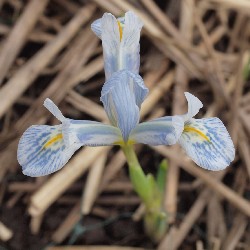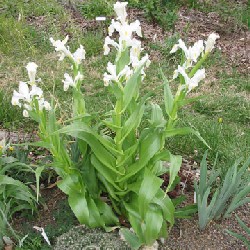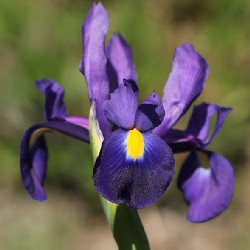Last But Not Least:
There are some groups of bulbous irises that deserve special mention here. They go by different names such as Dutch Iris, English Iris, Spanish Iris, Xiphiums, Reticulatas, and Junos. These species range from northern Africa & western Europe to central Asia.
 Reticulatas are a group of about a dozen species of dwarf irises that grow just a few inches tall. Some botanists classify them in Genus Iridodictyum but SIGNA follows the more common convention of placing them in Genus Iris. Reticulatas are some of the earliest irises to bloom, often with snow still on the ground. Most of them come from mountainous or forested regions from Turkey to Crimea to Iran. They are very popular with rock gardeners as they are bright, colorful, and small in stature.
Reticulatas are a group of about a dozen species of dwarf irises that grow just a few inches tall. Some botanists classify them in Genus Iridodictyum but SIGNA follows the more common convention of placing them in Genus Iris. Reticulatas are some of the earliest irises to bloom, often with snow still on the ground. Most of them come from mountainous or forested regions from Turkey to Crimea to Iran. They are very popular with rock gardeners as they are bright, colorful, and small in stature.
Al McMurtrie from Canada has been pioneering new advancements in hybridizing them for the horticultural trade. You can track his work and enjoy hundreds of photos on his Reticulata Iris site. He is successfully producing new flowers in shades of green, brown, orange, white, and teal. These are very different from the traditional blues, purples, and yellows that have dominated the trade for decades.
 Junos are a group of about 60 species of irises with bulbs and generally fleshy roots. One species hails from the Mediterranean. The others come from southwestern to central Asia. They have unique foliage that somewhat resembles a cornstalk instead of a normal iris fan. This results in some botanists placing them in Genus Juno, but SIGNA follows the convention of placing them in Genus Iris. They're also sometimes called Scorpiris, which is the name of the subgenus to which they belong.
Junos are a group of about 60 species of irises with bulbs and generally fleshy roots. One species hails from the Mediterranean. The others come from southwestern to central Asia. They have unique foliage that somewhat resembles a cornstalk instead of a normal iris fan. This results in some botanists placing them in Genus Juno, but SIGNA follows the convention of placing them in Genus Iris. They're also sometimes called Scorpiris, which is the name of the subgenus to which they belong.
In recent years Junos are enjoying a new found attention from hybridizers. Al McMurtrie (mentioned above) has a Juno Iris page with hundreds of photos of his species and hybrids. Flowers are usually a blend of colors including yellow, white, blue, or violet.
Plantarium.ru contains a fabulous database on Juno species with lots of in-situ photos.
 Xiphium is a subgenus of Iris consisting of 8 species from southwestern Europe and northern Africa which have large, smooth bulbs. They have been in cultivation since the 19th century. Subgroups are known as Spanish, English, and Dutch irises.
Xiphium is a subgenus of Iris consisting of 8 species from southwestern Europe and northern Africa which have large, smooth bulbs. They have been in cultivation since the 19th century. Subgroups are known as Spanish, English, and Dutch irises.
Foliage of these irises is very narrow, tall, and grass-like. Usually 1-3 flowers are borne atop tall unbranched stems in colors ranging from pink to yellow and white to blue and purple. These generally grow best in Mediterranean-like climates, but some of the hybrids will do well in colder, wetter climates.
These irises are big business for the cut-flower floral industry. If growing them to have cut flowers in your own home be sure to cut the stem leaving as much foliage as possible on the plant so it can replenish itself for next season.
 Species Iris Group of North America
Species Iris Group of North America